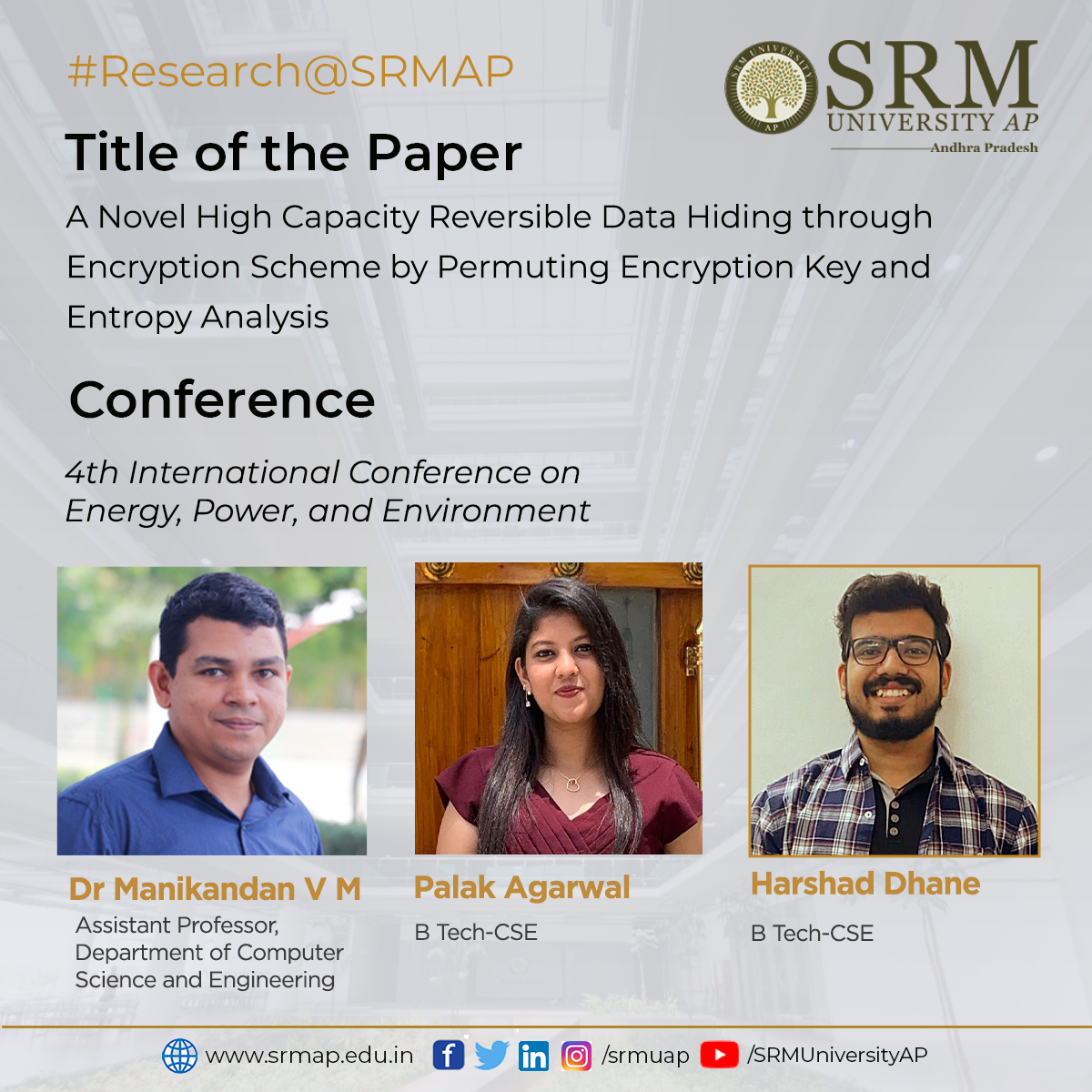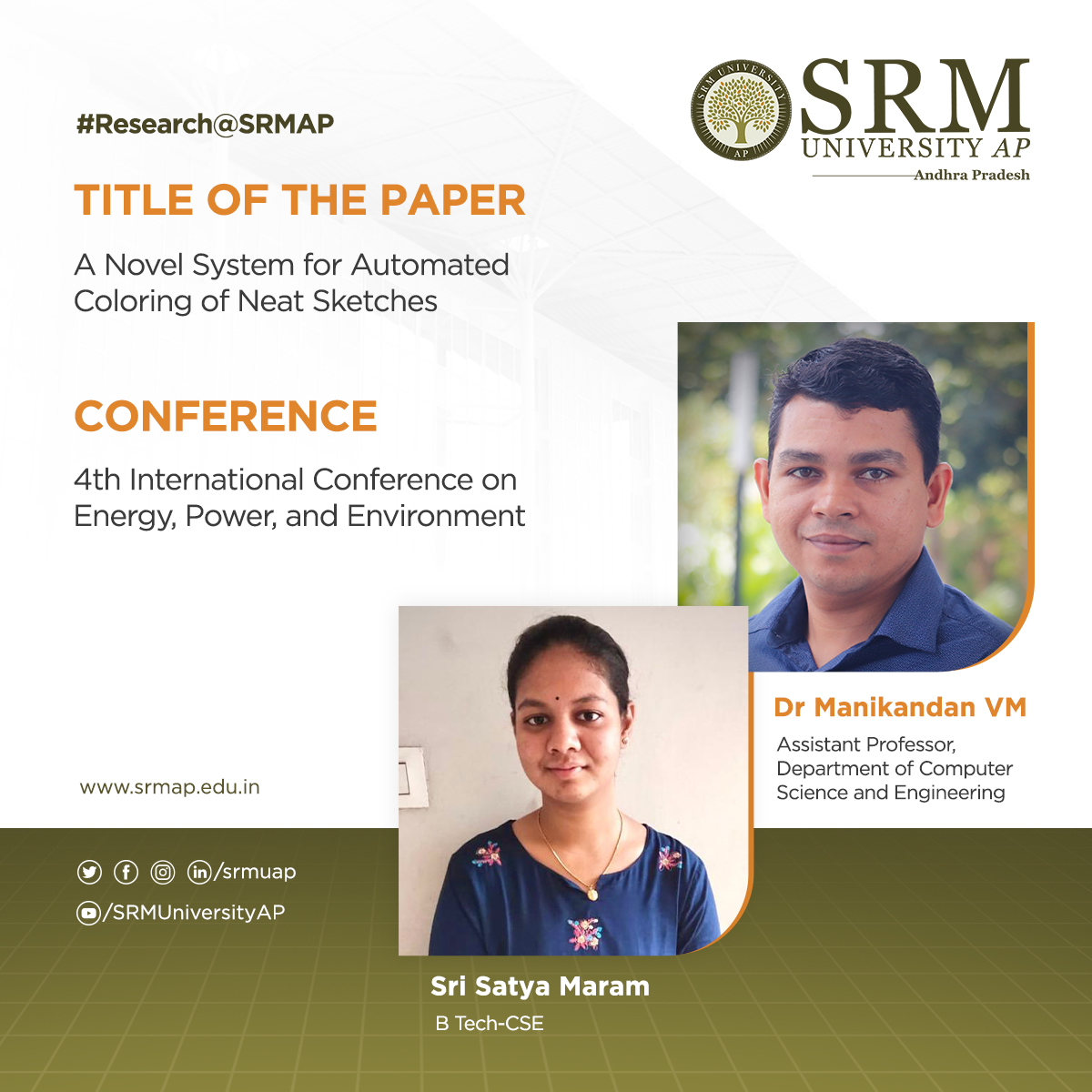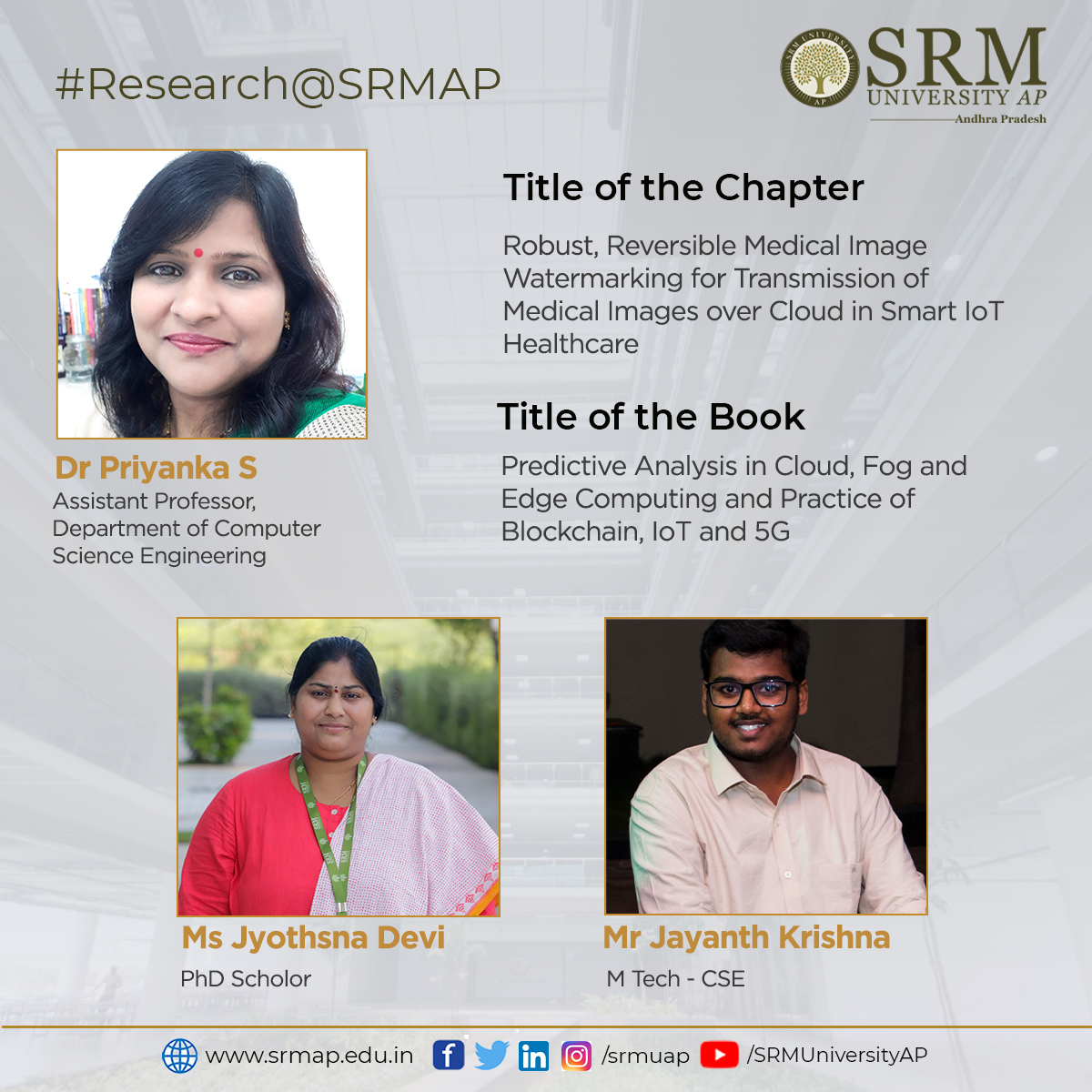Recent News
- Two paper presentations at the 4th International Conference on Energy, Power, and Environment July 1, 2022
Two research papers from the Department of Computer Science and Engineering were presented at the 4th International Conference on Energy, Power, and Environment held from April 29 to May 1, 2022. Assistance professor V M Manikandan and three BTech students participated in the conference organised by NIT Meghalaya, India. The papers will be published in IEEE Xplore Digital Library (Scopus Indexed).
 Third-year BTech CSE student Harshad Dhane presented the paper A Novel High Capacity Reversible Data Hiding through Encryption Scheme by Permuting Encryption Key and Entropy Analysis, co-authored by Palak Agarwal, third-year BTech student, and Dr V M Manikandan. The reversible data hiding scheme proposed by the research can be used in the healthcare sector to transmit electronic patient reports along with medical images. Improving the embedding rate of the reversible data hiding is the further plan of the researchers.
Third-year BTech CSE student Harshad Dhane presented the paper A Novel High Capacity Reversible Data Hiding through Encryption Scheme by Permuting Encryption Key and Entropy Analysis, co-authored by Palak Agarwal, third-year BTech student, and Dr V M Manikandan. The reversible data hiding scheme proposed by the research can be used in the healthcare sector to transmit electronic patient reports along with medical images. Improving the embedding rate of the reversible data hiding is the further plan of the researchers.Explanation of the research
A Reversible Data Hiding Through Encryption (RDTE) scheme will consider an original image and a sequence of bits as the input and generate an encrypted image as the output. This encrypted image will be able to transmit through the network securely, and the authorized receiver can take out the hidden details along with the restoration of the actual image. This paper proposes a new RDTE scheme with a good rate of embedding without any issues during the restoration of the original image. The researchers used the well-known RC4 pseudo-random generator for the image encryption and performed data hiding during block-wise image encryption. In the proposed scheme, the original image is considered non-overlapping blocks of size BXB pixels, and these blocks will be encrypted using a sequence of pseudo-random integers. During the RDTE process, all the possible unique permutations of the encryption key, K, will be generated, say (K0, K1,…, KN). Further, the sender will be capable of embedding one integer value from the set {0, 1, …,N} in a selected image block. A selected block will be encrypted using the pseudo-random sequence of integers using the key K_Q to embed the integer Q in the selected block. The proposed scheme prefers to select keys with unique characters with sufficient length to ensure the maximum embedding capacity. The message extraction and image restoration are performed by analysing the entropy measure from each block after attempting the decryption.
 The paper presented by second year BTech CSE student Sri Satya Maram is titled A Novel System for Automated Coloring of Neat Sketches and was co-authored by Dr V M Manikandan. The research introduces a new algorithm to colour a given neat sketch. The proposed algorithm can be used to colour drawings to create animated movies or to colour the designs developed by the designers. The researchers plan to develop artistic features on the coloured image for better visual appearance.
The paper presented by second year BTech CSE student Sri Satya Maram is titled A Novel System for Automated Coloring of Neat Sketches and was co-authored by Dr V M Manikandan. The research introduces a new algorithm to colour a given neat sketch. The proposed algorithm can be used to colour drawings to create animated movies or to colour the designs developed by the designers. The researchers plan to develop artistic features on the coloured image for better visual appearance.Explanation of the research
The process of colouring neat sketches is a significant activity when making animated movies or for better visualization in computer modelling. The colour filling tools are widely available in almost all the image/video editing software, which will help us pick a colour from a colour palette and can be filled in a selected region. This process is known as flat colouring. The flat colouring process has several challenges. One of the significant challenges is that the colour may leak from the selected regions to neighbouring regions if there are some small openings on the contours. The second concern while using flat colouring is that the designated areas will be filled entirely with the same colour, so the drawing will not have an artistic look. The research proposes a new software application that will take a neat sketch as the input, and the system will generate a coloured drawing as the output. In the proposed scheme, the researchers have converted the given sketch to a grayscale or binary image and applied image dilation operation to fill the small open spaces in the contours (if any). Further, the closed regions are identified and coloured with a predefined set of colours or random colour combinations. While colouring the regions, the proposed system will ensure that the adjacent regions will not be coloured with the same colours. A number of sketches have been considered during the experimental study, and the results are validated manually.
Continue reading → - Computational intelligence and the healthcare system June 30, 2022
 Computational and artificial intelligence is enjoying an unparalleled relevance in the modern world. They improve people’s lives and are highly anticipated in the healthcare industry. Research in this domain is hugely appreciated by the contemporary world, considering its potential to create revolutionary changes in the health care system. The Department of Computer Science and Engineering is delighted to inform you that the paper Robust, Reversible Medical Image Watermarking for Transmission of Medical Images over Cloud in Smart IoT Healthcare has been accepted for publishing as a chapter in the book Predictive Analysis in Cloud, Fog and Edge Computing and Practice of Blockchain, IoT and 5G.
Computational and artificial intelligence is enjoying an unparalleled relevance in the modern world. They improve people’s lives and are highly anticipated in the healthcare industry. Research in this domain is hugely appreciated by the contemporary world, considering its potential to create revolutionary changes in the health care system. The Department of Computer Science and Engineering is delighted to inform you that the paper Robust, Reversible Medical Image Watermarking for Transmission of Medical Images over Cloud in Smart IoT Healthcare has been accepted for publishing as a chapter in the book Predictive Analysis in Cloud, Fog and Edge Computing and Practice of Blockchain, IoT and 5G.The paper was submitted by Assistant Professor Dr Priyanka S, her PhD student Ms Jyothsna Devi, and MTech student Mr Jayant Krishna. The book chapter for the edited book is entitled Predictive Data Security using Ai – Insights and Issues of Blockchain, IoT, and DevOps and is published by Springer Nature. It is a part of the book series, Studies in Computational Intelligence, indexed by SCOPUS.
The book Studies in Computational Intelligence targets to bring together researchers and practitioners in computational intelligence and AI technology, especially those related to the areas of Machine learning, blockchain, multimedia using AI, smart IoT environment and email spam and online surveys, and many more recent emerging fields. The research work mainly provides highly secure, robust medical image transmission over the cloud in a smart IoT healthcare environment to ensure high embedding capacity and integrity.
This book’s target audience comprises professionals and researchers working in the field of computational intelligence and AI for health services in a smart environment. The book will attract Engineers (computer, industrial, software, and others), health care scholars, and information scientists since it caters to their interests.
Continue reading →

